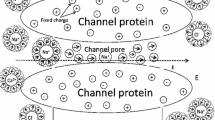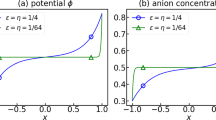Abstract
A continuum model, based on the Poisson–Nernst–Planck (PNP) theory, is applied to simulate steady-state ion flux through protein channels. The PNP equations are modified to explicitly account (1) for the desolvation of mobile ions in the membrane pore and (2) for effects related to ion sizes. The proposed algorithm for a three-dimensional self-consistent solution of PNP equations, in which final results are refined by a focusing technique, is shown to be suitable for arbitrary channel geometry and arbitrary protein charge distribution. The role of the pore shape and protein charge distribution in formation of basic electrodiffusion properties, such as channel conductivity and selectivity, as well as concentration distributions of mobile ions in the pore region, are illustrated by simulations on model channels. The influence of the ionic strength in the bulk solution and of the externally applied electric field on channel properties are also discussed.










Similar content being viewed by others
References
Alexov E, Gunner MR (1997) Incorporating protein conformational flexibility into the calculation of pH-dependent protein properties. Biophys J 72:2075–2093
Allen TW, Kuyucak S, Chung H (2000) Molecular dynamics estimates of ion diffusion in model hydrophobic and KcsA potassium channels. Biophys Chem 86:1–14
Boda D, Busath DD, Henderson D, Sokolowski S (2000) Monte Carlo simulations of the mechanism of channel selectivity: the competition between volume exclusion and charge neutrality. J Phys Chem B 104:8903–8910
Boda D, Henderson D, Busath DD (2001) Monte Carlo study of the effect of ion and channel size on the selectivity of a model calcium channel. J Phys Chem B 105:11574–11577
Cardenas AE, Coalson RD, Kurnikova MG (2000) Three-dimensional Poisson-Nernst-Planck theory studies: Influence of membrane electrostatics on gramicidin A channel conductance. Biophys J 79:80–93
Chung SH, Hoyles M, Allen T, Kuyucak S (1998) Study of ionic currents across a model membrane channel using Brownian dynamics. Biophys J 75:793–809
Corry B, Kuyucak S, Chung SH (2000) Tests of continuum theories as models of ion channels. II. Poisson-Nernst-Planck theory versus Brownian dynamics. Biophys J 78:2364–2381
Corry B, Allen TW, Kuyucak S, Chung SH (2001) Mechanisms of permeation and selectivity in calcium channels. Biophys J 80:195–214
Dieckmann GR, Lear JD, Zhong QF, Klein ML, DeGrado WF, Sharp KA (1999) Exploration of the structural features defining the conduction properties of a synthetic ion channel. Biophys J 76:618–630
Dillet V, van Etten RL, Bashford D (2000) Stabilization of charges and protonation state in the active site of the protein tyrosine phosphatases: a computational study. J Phys Chem B 104:11321–11333
Eisenberg RS (1996) Computing the field in proteins and membranes. J Membr Biol 150:1–25
Gillespie D, Eisenberg R (2001) Modified Donnan potentials for ion transport through biological ion channels. Phys Rev E 63:061902-0611-7
Gillespie D, Eisenberg RS (2002) Physical descriptions of experimental selectivity measurements in ion channels. Eur Biophys J 31:454–466
Gilson M, Sharp KA, Honig BH (1987) Calculating electrostatic potential of molecules in solution: method and error assessment. J Comput Chem 9:327–335
Goulding D, Hansen JP, Melchionna S (2000) Size selectivity of narrow pores. Phys Rev Lett 85:1132–1135
Goulding D, Melchionna S, Hansen JP (2001) Entropic selectivity of microporous materials. Phys Chem Chem Phys 3:1644–1654
Graf P, Nitzan A, Kurnikova MG, Coalson RD (2000) A dynamic lattice Monte Carlo model of ion transport in inhomogeneous dielectric environments: method and implementation. J Phys Chem B 104:12324–12338
Gummel HK (1964) A self-consistent iterative scheme for one-dimensional steady state transistor calculations. IEEE Trans Electron Devices ED-11:455–465
Gunner MR, Alexov E (2000) A pragmatic approach to structure based calculation of coupled proton and electron transfer in proteins. Biochim Biophys Acta 1458:63–87
Hadjidimos A (2000) Successive overrelaxation (SOR) and related methods. J Comp Appl Math 123:177–199
Hollerbach U, Chen D, Nonner W, Eisenberg B (1999) Three dimensional Poisson-Nernst-Planck theory of open channels. Biophys J 76:A205
Hollerbach U, Chen DP, Busath DD, Eisenberg B (2000) Predicting function from structure using the Poisson-Nernst-Planck equations: sodium current in the gramicidin A channel. Langmuir 16:5509–5514
Jerome JW (1996) Analysis of charge transport: a mathematical study of semiconductor devices. Springer, Berlin Heidelberg New York
Karshikoff A (1995) A simple algorithm for calculation of multiple site titration curves. Protein Eng 8:243–248
Karshikoff A, Spassov V, Cowan RQ, Ladenstein R, Schirmer T (1994) Electrostatic analysis of two porin channels from E. coli. J Mol Biol 240:372–384
Koumanov A, Rüterjans H, Karshikoff A (2002) Continuum electrostatic analysis of irregular ionization and proton allocation in proteins. Proteins 46:85–96
Koumanov A, Benach J, Atrian S, Gonzàlez-Duarte R, Karshikoff A, Ladenstein R (2003) The catalytic mechanism of Drosophila alcohol dehydrogenase: evidence for a proton relay modulated by the coupled ionisation of the active site lysine/tyrosine pair and a NAD+ ibose OH switch. Proteins (in press)
Kurnikova MG, Coalson RD, Graf P, Nitzan A (1999) A lattice relaxation for three-dimensional Poisson-Nernst-Planck theory with application to ion transport through the gramicidin A channel. Biophys J 76:642–656
Levitt DG (1999) Modeling of ion channels. J Gen Physiol 113:789–794
Moy G, Corry B, Kuyucak S, Chung,S H (2000) Tests of continuum theories as models of ion channels. I. Poisson-Boltzmann theory versus Brownian dynamics. Biophys J 78:2349–2363
Nicholls A, Honig B (1991) A rapide finite difference algorithm, utilizing successive over-relaxation to solve the Poisson-Boltzmann equation. J Comput Chem 12:435–445
Nonner W, Eisenberg B (1998) Ion permeation and glutamate residues linked by Poisson-Nernst-Planck theory in L-type calcium channels. Biophys J 75:1287–1305
Nonner W, Chen DP, Eisenberg B (1998) Anomalous mole fraction effect, electrostatics, and binding in ionic channels. Biophys J 74:2327–2334
Nonner W, Chen DP, Eisenberg B (1999) Progress and prospects in permeation. J Gen Physiol 113:773–782
Nonner W, Catacuzzeno L, Eisenberg B (2000) Binding and selectivity in L-type Ca channels: a mean spherical approximation. Biophys J 79:1976–1992
Nonner W, Gillespie D, Henderson D, Eisenberg B (2001) Ion accumulation in a biological calcium channel: effects of solvent and confining pressure. J Phys Chem B 105:6427–6436
Partenskii MB, Jordan PC (1992) Theoretical perspectives on ion-channel electrostatics: continuum and microscopic approaches. Q Rev Biophys 25:477–510
Riveros O, Croxton T, Armstrong WMD (1989) Liquid junction potentials calculated from numerical solutions of the Nernst-Planck and Poisson equations. J Theor Biol 140:221–230
Robinson RA, Stokes RH (1959) Electrolyte solutions: the measurement and interpretation of conductance, chemical potential and diffusion in solutions of simple electrolytes, 2nd edn. Butterworths, London
Roux B (2002) Theoretical and computational models of ion channels. Curr Opin Struct Biol 12:182–189
Sansom MSP, Smith GR, Adcock C, Biggin PC (1997) The dielectric properties of water within model transbilayer pores. Biophys J 73:2404–2415
Sartoris G (1998) A 3D rectangular mixed finite element method to solve the stationary semiconductor equations. SIAM J Sci Comput 19:387–403
Schuss Z, Nadler B, Eisenberg RS (2001) Derivation of Poisson and Nernst-Planck equations in a bath and channel from a molecular model. Phys Rev E 64:036116
Selberherr S (1984) Analysis and simulation of semiconductor devices. Springer, Berlin Heidelberg New York
Smith GR, Sansom MSP (1999) Effective diffusion coefficients of K+ and Cl− ions in ion channel models. Biophys Chem 79:129–151
Tieleman D, Berendsen H (1998) A molecular dynamics study of the pores formed by Escherichia coli OmpF porin in a fully hydrated palmitoyloleoylphosphatidylcholine bilayer. Biophys J 74:2786–2801
Tieleman DP, Biggin PC, Smith GR, Sansom MSP (2001) Simulation approaches to ion channel structure–function relationships. Q Rev Biophys 34:473–561
Voges D, Karshikoff A (1998) A model for a local static dielectric constant in macromolecules. J Phys Chem 108:2219–2227
Warwicker J, Watson NC (1982) Calculation of the electric field potential in the active site cleft due to alpha-helix dipoles. J Mol Biol 157:671–679
Zachariae U, Koumanov A, Engelhardt H, Karshikoff A (2002) Electrostatic properties of the anion selective porin Omp32 from Delftia acidovorans and of the arginine cluster of bacterial porins. Protein Sci 11:1309–1319
Acknowledgements
U.Z. thanks EMBO for a short-term fellowship, ASTF 9864.
Author information
Authors and Affiliations
Corresponding author
Rights and permissions
About this article
Cite this article
Koumanov, A., Zachariae, U., Engelhardt, H. et al. Improved 3D continuum calculations of ion flux through membrane channels. Eur Biophys J 32, 689–702 (2003). https://doi.org/10.1007/s00249-003-0330-y
Received:
Revised:
Accepted:
Published:
Issue Date:
DOI: https://doi.org/10.1007/s00249-003-0330-y




